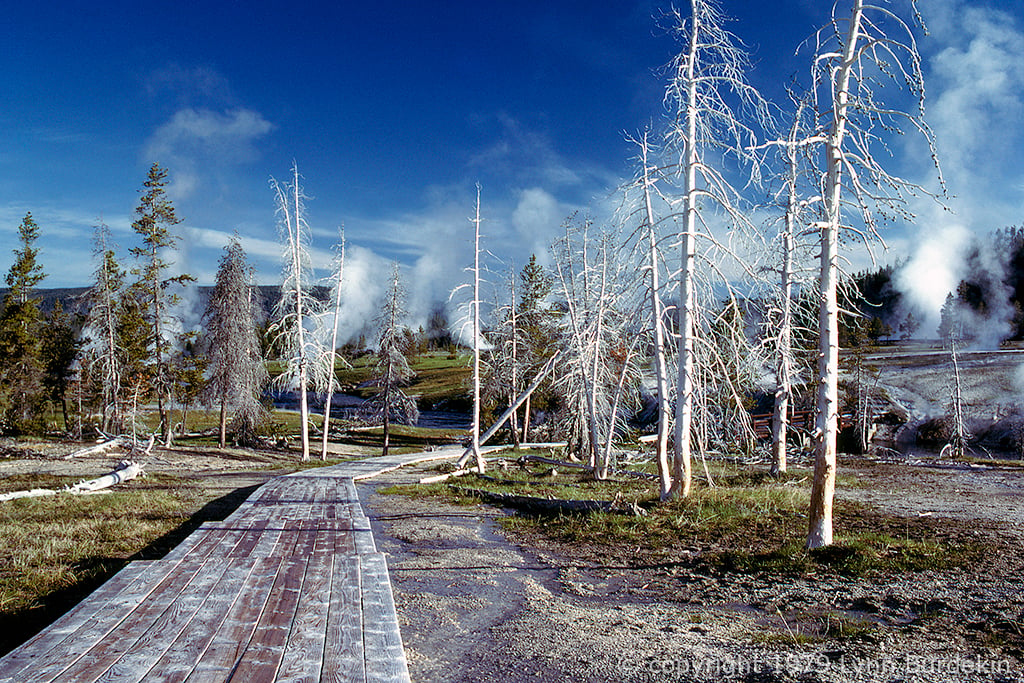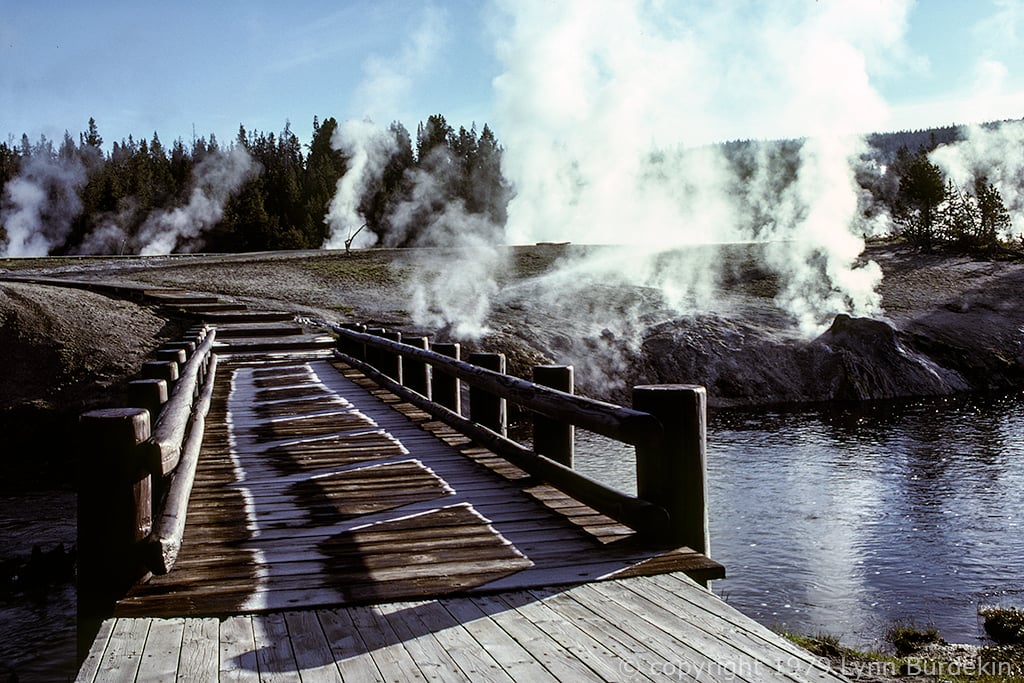DownUnder
Nikon Nomad
@DownUnder I know this to be the case with many Agfachromes. Never heard it being an issue with Ektachromes (at least myself and my brother never had it).
My Agfchromes have faded to the point that they are now all like sepia tints... Hey make good B&W images, and it may be bes to scan them as such to preserve them. My American Ektachrome are still amazingly good. The Australian ones are scrap.
raid
Dad Photographer
The Fujichromes seem to still look fine to my eyes. Does anyone here see issues with their Fujichrome slides?
Freakscene
Obscure member
All E6 fades eventually. They fade faster if the processing is poor and they aren’t properly stabilised.The Fujichromes seem to still look fine to my eyes. Does anyone here see issues with their Fujichrome slides?
I could write an essay about film processing in Australia, but I can assure you that K14 was done as well in Australia as anywhere. Almost all Kodachrome in Australia was sold with pre-paid processing and came with a mailer. But Lynn can tell us what he did.
raid
Dad Photographer
This makes sense. I
Fujichrome is for E6 after all.
Fujichrome is for E6 after all.
Dogman
Mentor
All my Agfachrome slides from the 70s are pretty much toast today. They've faded to a brownish tone like DownUnder mentions.
There were a number of independent labs processing Kodachrome in the past. Sadly, some of them were subpar. I have some Kodachrome slides that show signs of fading as well.
The Kodachromes processed by Kodak and the Ektachromes and Fujichromes are all okay, as well as I can remember. I haven't looked at them in some time.
There were a number of independent labs processing Kodachrome in the past. Sadly, some of them were subpar. I have some Kodachrome slides that show signs of fading as well.
The Kodachromes processed by Kodak and the Ektachromes and Fujichromes are all okay, as well as I can remember. I haven't looked at them in some time.
CMur12
Well-known
I have Agfachrome CT18 slides from 1972 that show no visible deterioration. I'm guessing that climate has an impact on this film's longevity. I've lived in a dry climate for the last 40 years, though my slides were stored in a more humid climate before that.
- Murray
- Murray
DownUnder
Nikon Nomad
I have Agfachrome CT18 slides from 1972 that show no visible deterioration. I'm guessing that climate has an impact on this film's longevity. I've lived in a dry climate for the last 40 years, though my slides were stored in a more humid climate before that.
- Murray
When I went to Bali in 1972 I took mostly Ektachrome, but during a stopover in Australia I bought up big in Melbourne. I liked Agfa colors so I blew my modest travel budget wide open on a brick of CT18 from the now-defunct Michael's Photo on Elizabeth Street. All used in Asia and eventually processed when I returned to Australia, some three months later. Most of my slide films stayed in one of my Holdalls in the various fleapit hotels I stayed in, subjected to whatever hellish temperatures those tropical days were, which oddly did not seem to do any damage to the colors, at least in the short term.
Like CMur12, my Agfachromes are 90% as good as they were back in the day. Much of my Ektachrome shows signs of fading but can still be scanned and printed. I was never into Fujichrome tho' I did use a few rolls of their standard (I think it was ISO 64) slide film in Indonesia in the 1980s. Most of these are now a delightful shade of either green or yellow, but they still scan well for B&W conversion.
I was photographically rather naive in those days, in that I didn't realise Kodak Australasia was based in Melbourne and did all the Kodachrome processing for Asia and the Pacific. I found this out when I returned to Australia to stay permanently in 1976, and from that time on I used mostly K64 and K25. I recall Kodak introduced 120 Kodachrome in the mid-1980 and I used quite a lot of it for the few years it was available, as I had a Rolleiflex and film was affordable in that time. I've not looked at those beaut 120 'chromes for a long time - I must go and dig them out to see how they have fared. I recall the film had a slight greenish tinge which gave well-tanned people a sort of Martian look, which may be why it never really took off as a studio film like Ektachrome did.
I recall a conversation with Andrew Brown from Kodak in Coburg, who was an absolute wizard of data and helpful information in his time but as I recall left Kodak very suddenly during one of their staff shake-ups, in which he told me one of the worst destroyers of slides was to project them. I've never owned a slide projector and to this day when I sort out slides I use an ancient Agfascope hand viewer I bought in the '70s. It uses a refrigerator light globe for illumination which surely must have done little or no damage to my images over the years.
I'm old enough to (barely) remember that "serious" photographers in the 1950s still used view cameas and 8x10" Kodachrome sheet film for landscapes and even in studio work, mostly product photography. Or it may have been Ektachrome. Whichever it was, the cost would have been reasonable, unlike now when everything to do with photography is expensive.
Old memories here.
Last edited:
CMur12
Well-known
... I've not looked at those beaut 120 'chromes for a long time - I must go and dig them out to see how they have fared. I recall the film had a slight greenish tinge which gave well-tanned people a sort of Martian look, which may be why it never really took off as a studio film like Ektachrome did. ...
I have some Kodachrome slides in 120 that I really like. Of course, they still look great.
Regarding the greenish tinge, brand new "amateur" Kodachrome could lean green. With a little more maturing, the color would correct itself, then it would age into magenta. With professional film, they aged it to maturity (correct color balance), then chilled it to slow further aging, and sold it refrigerated. I thought that 120 slide film was only sold as professional film, so it surprises me if you got a greenish tinge in 120 Kodachrome.
- Murray
Freakscene
Obscure member
I was photographically rather naive in those days, in that I didn't realise Kodak Australasia was based in Melbourne and did all the Kodachrome processing for Asia and the Pacific. I found this out when I returned to Australia to stay permanently in 1976, and from that time on I used mostly K64 and K25. I recall Kodak introduced 120 Kodachrome in the mid-1980 and I used quite a lot of it for the few years it was available, as I had a Rolleiflex and film was affordable in that time. I've not looked at those beaut 120 'chromes for a long time - I must go and dig them out to see how they have fared. I recall the film had a slight greenish tinge which gave well-tanned people a sort of Martian look, which may be why it never really took off as a studio film like Ektachrome did.
Kodachrome 64 in 120 had been available for a long time; it was only distributed patchily. It was discontinued in 1996. Done properly, it could look really gorgeous.
I recall a conversation with Andrew Brown from Kodak in Coburg, who was an absolute wizard of data and helpful information in his time but as I recall left Kodak very suddenly during one of their staff shake-ups, in which he told me one of the worst destroyers of slides was to project them. I've never owned a slide projector and to this day when I sort out slides I use an ancient Agfascope hand viewer I bought in the '70s. It uses a refrigerator light globe for illumination which surely must have done little or no damage to my images over the years.
I knew Andrew and he assisted with some of my training, including my Q-Lab operator certification. That seems like eye of newt stuff now.
Absolutely. And the eternal fights about K14 versus E6 ‘longevity’ usually overlooked use and storage. In dark storage, Kodachrome lasts much, much longer. But E6 handles projection better. Kodak made an E6 film for copying Kodachromes for projection, with a rather complicated table of filtration for the copying step to manage the colour shifts, and another for pre-exposures and other shananigans to manage contrast build-up. If you have a big archive, get scanning, and as for the copy film, it’s long gone so that’s all academic/historical now.
I'm old enough to (barely) remember that "serious" photographers in the 1950s still used view cameas and 8x10" Kodachrome sheet film for landscapes and even in studio work, mostly product photography. Or it may have been Ektachrome. Whichever it was, the cost would have been reasonable, unlike now when everything to do with photography is expensive.
Old memories here.
Advertising and tabletop photographers still used a lot of sheet film into the 1990s. EPP was popular because the colour balance could be managed very effectively, and in larger sizes its more robust grain structure didn’t matter. 135 EPP was also popular for cross-processing, a strange late film period fad which thankfully vanished with film as a common commercial medium. Trying to print EPP cross processed as a negative on RA4 paper was trying.
I have some Kodachrome slides in 120 that I really like. Of course, they still look great.
Regarding the greenish tinge, brand new "amateur" Kodachrome could lean green. With a little more maturing, the color would correct itself, then it would age into magenta. With professional film, they aged it to maturity (correct color balance), then chilled it to slow further aging, and sold it refrigerated. I thought that 120 slide film was only sold as professional film, so it surprises me if you got a greenish tinge in 120 Kodachrome.
- Murray
Yes, Kodachrome Professional was aged and colour tested and all the 120 Kodachrome was Kodachrome Professional. Anything is possible with time and/or poor processing - the decentralisation of Kodachrome processing in the US in the 1980s and onwards meant that there were all sorts of variable quality operators. In Australia, only Kodak processed K14.
Lynn, tell us about your processing when you can.
Marty
Stelios
Well-known
I do hope this thread returns!
Archiver
Mentor
I've mentioned this before, but what was the old Kodak property in Coburg has now become a residential development, which has delightful street names like Snapshot Drive, Pixel Circuit and Cyan Way! I talked to an older photographer who used to get all his Kodachrome developed at Coburg. There's a hairdresser on the outskirts of the site who has been there for decades, and used to cut the hair of many Kodak employees.I was photographically rather naive in those days, in that I didn't realise Kodak Australasia was based in Melbourne and did all the Kodachrome processing for Asia and the Pacific. I found this out when I returned to Australia to stay permanently in 1976, and from that time on I used mostly K64 and K25. I recall Kodak introduced 120 Kodachrome in the mid-1980 and I used quite a lot of it for the few years it was available, as I had a Rolleiflex and film was affordable in that time. I've not looked at those beaut 120 'chromes for a long time - I must go and dig them out to see how they have fared. I recall the film had a slight greenish tinge which gave well-tanned people a sort of Martian look, which may be why it never really took off as a studio film like Ektachrome did.
I recall a conversation with Andrew Brown from Kodak in Coburg, who was an absolute wizard of data and helpful information in his time but as I recall left Kodak very suddenly during one of their staff shake-ups, in which he told me one of the worst destroyers of slides was to project them. I've never owned a slide projector and to this day when I sort out slides I use an ancient Agfascope hand viewer I bought in the '70s. It uses a refrigerator light globe for illumination which surely must have done little or no damage to my images over the years.
I find it a bit of a shame that the Kodak area's legacy is known only in the names of the streets, and there is no public museum or anything in that area. It would have been nice for the developers to create and maintain a smallish building with historical displays and material from the old site, much like was done with the nearby Pentridge prison development. They retained much of the old prison walls and created a historical gallery in the supermarket/cinema complex. But I suppose that the Kodak site wasn't deemed of sufficient historical significance to memorialize in that way.
DownUnder
Nikon Nomad
I've mentioned this before, but what was the old Kodak property in Coburg has now become a residential development, which has delightful street names like Snapshot Drive, Pixel Circuit and Cyan Way! I talked to an older photographer who used to get all his Kodachrome developed at Coburg. There's a hairdresser on the outskirts of the site who has been there for decades, and used to cut the hair of many Kodak employees.
I find it a bit of a shame that the Kodak area's legacy is known only in the names of the streets, and there is no public museum or anything in that area. It would have been nice for the developers to create and maintain a smallish building with historical displays and material from the old site, much like was done with the nearby Pentridge prison development. They retained much of the old prison walls and created a historical gallery in the supermarket/cinema complex. But I suppose that the Kodak site wasn't deemed of sufficient historical significance to memorialize in that way.
I've mentioned this before, but what was the old Kodak property in Coburg has now become a residential development, which has delightful street names like Snapshot Drive, Pixel Circuit and Cyan Way! I talked to an older photographer who used to get all his Kodachrome developed at Coburg. There's a hairdresser on the outskirts of the site who has been there for decades, and used to cut the hair of many Kodak employees.
I find it a bit of a shame that the Kodak area's legacy is known only in the names of the streets, and there is no public museum or anything in that area. It would have been nice for the developers to create and maintain a smallish building with historical displays and material from the old site, much like was done with the nearby Pentridge prison development. They retained much of the old prison walls and created a historical gallery in the supermarket/cinema complex. But I suppose that the Kodak site wasn't deemed of sufficient historical significance to memorialize in that way.
You would surely remember that the only photo museum in Melbourne, and maybe in Australia, was Michael's in Elizabeth Street in the city. I recall it wasn't particularly well organized and maybe best described as "borderline clutter" but there were many fine cameras and a few rarities. The collection of Leica LTM gear made Leitz fanatics drool.
I visited many times over the years until the shop closed a couple of years ago. Now I hear the collection is being prepared to be sold at auction, or maybe it already has. Sad that it will be flogged off and dispersed, but that's the era we now live in.
I also fondly remember the Kodak Shop on Collins Street, not far from Leon Splitter's photo shop on Elizabeth Street. Both now long gone. I often bought my Kodachrome from Kodak and Leon sold me one or two fine cameras, sadly I no longer have them. On bad days Leon could be a handful to deal with and his offhand comments held a nasty bite and offended many would be customers, but he knew his trade and he was a good man with a fine reputation. Sadly,I was told he made some poor business decisions and had to sell out and leave the business.
So many good photo shops now gone from the CBD. A scant few remain in the suburbs. Time passes too quickly.
Last edited:
Archiver
Mentor
I have many, many photos of Michael's Camera Museum. It was one of my stops on any City-based photo walk, especially on Grand Final Day. A walk would begin with grabbing some sushi and scoffing that down while walking up Lonsdale St towards Elizabeth, and finishing just before I reached the traffic lights near the church. From there, cross the road and into the wonders of Michael's Cameras. Apart from the Leica LTM gear, there were a few quirky collections like a line of Olympux XA models including a rare red one, a line of Pentax MX cameras, all the Zeiss Isowhatevers you can imagine, and even some early Kodak digital cameras.You would surely remember that the only photo museum in Melbourne, and maybe in Australia, was Michael's in Elizabeth Street in the city. I recall it wasn't particularly well organized and maybe best described as "borderline clutter" but there were many fine cameras and a few rarities. The collection of Leica LTM gear made Leitz fanatics drool.
I visited many times over the years until the shop closed a couple of years ago. Now I hear the collection is being prepared to be sold at auction, or maybe it already has. Sad that it will be flogged off and dispersed, but that's the era we now live in.
The first batch of items from Michaels sold last year, I am not sure if/when the rest will be sold. The first lot included the giant Leica III model that was suspended in the staircase, I think this was bought by 'Rambo' Peter the Leica collector and dealer in Sydney. It was sad that Michaels closed and the museum contents auctioned off.
This photo cannot convey the scope and breadth of items on display. It was cluttered, yes, but you would notice something new every time you went. Note the red XA on the top shelf. I wish I'd had the time to go back and photograph every single cabinet in that place before it closed.
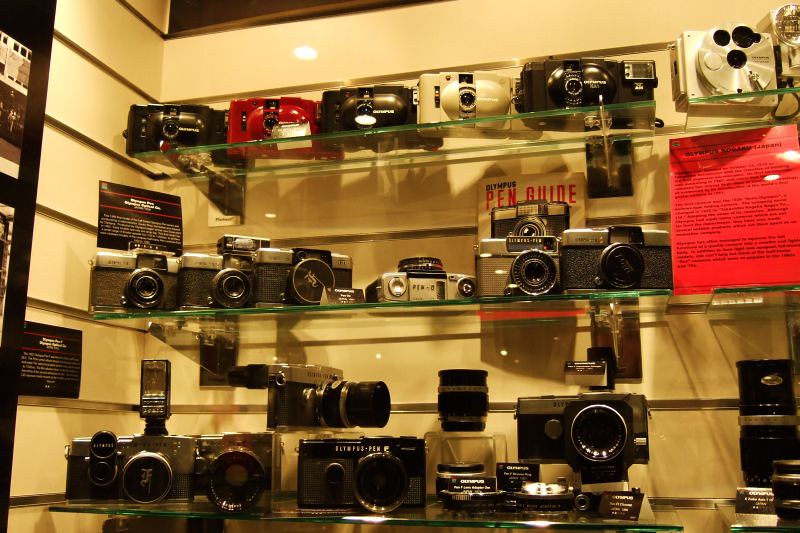 F30 - Michael's Camera Museum by Archiver, on Flickr
F30 - Michael's Camera Museum by Archiver, on FlickrCamera House on Elizabeth closed some years ago - I think that was on the corner, opposite where Digidirect is now. Camera Exchange moved to an industrial park in Box Hill, and Camera Lane moved to the same street at the Visy glass recycling plant in Spotswood. This water tank thing is in the same street as Camera Lane.I also fondly remember the Kodak Shop on Collins Street, not far from Leon Splitter's photo shop on Elizabeth Street. Both now long gone. I often bought my Kodachrome from Kodak and Leon sold me one or two fine cameras, sadly I no longer have them. On bad days Leon could be a handful to deal with and his offhand comments held a nasty bite and offended many would be customers, but he knew his trade and he was a good man with a fine reputation. Sadly,I was told he made some poor business decisions and had to sell out and leave the business.
So many good photo shops now gone from the CBD. A few remain, in the suburbs. Time passes so quickly.
 GX85 - Welcome to Spotswood by Archiver, on Flickr
GX85 - Welcome to Spotswood by Archiver, on FlickrTeds and Digidirect are the only camera shops in Elizabeth Street now, apart from the camera section at JB Hifi. My main man at Teds, the redoubtable Steve Mills, retired a few years before the pandemic. He was always fun to chat with, his knowledge of Leica was deep, and he sometimes spoke at Australian LHSA chapter meetings. I must give him a call and see how he is.
But anyway, we're taking @lynnb topic wayyyy off course!
robert blu
quiet photographer
Lovely scenery!#USA24-34 Rocky Mountains, eastern access to Yellowstone NP, Wyoming, 01 June 1979
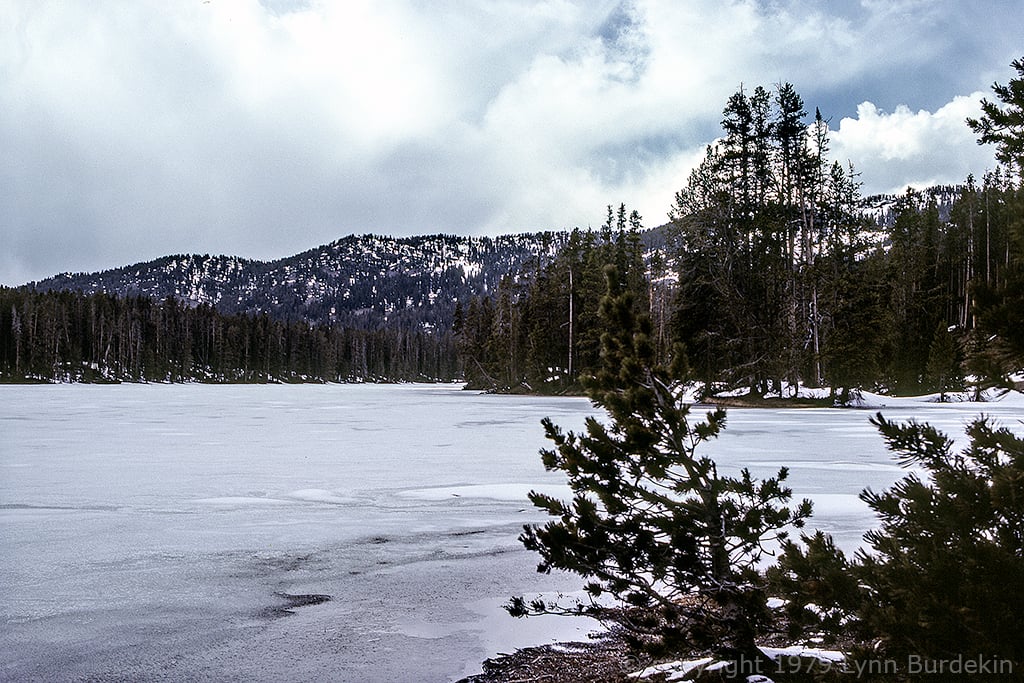
DownUnder
Nikon Nomad
Lynn appears to be MIA. I did a snoop-check and noted he logged in a few days ago. !!!
I hope he returns and keeps this wonderful thread going, it was a 'changer' in many ways for RFF and spawned one or more similar others. Greatly needed around these parts, I reckon we have all gone a bit 'stale' nowadays.
I hope he returns and keeps this wonderful thread going, it was a 'changer' in many ways for RFF and spawned one or more similar others. Greatly needed around these parts, I reckon we have all gone a bit 'stale' nowadays.
Archiver
Mentor
Agreed, this is a super thread with so many awesome images of historical significance. Looking at them is like immersing yourself in someone else's memories, perhaps because many of them are POV images like being inside a car, at the roadside, etc. The people are distant enough to not be recognizable, but they are scenes from the trip nevertheless. There's a natural, 'artless' feeling to them that isn't contrived, set up or overly composed. Just a good photographer having a blast on the road trip of a lifetime and capturing what he sees.Lynn appears to be MIA. I did a snoop-check and noted he logged in a few days ago. !!!
I hope he returns and keeps this wonderful thread going, it was a 'changer' in many ways for RFF and spawned one or more similar others. Greatly needed around these parts, I reckon we have all gone a bit 'stale' nowadays.
lynnb
Mentor
Sorry guys I've been tied up with family health issues for the last 4 months - unfortunately this is ongoing so it may be a while between drinks. I've checked in once or twice to respond to PMs but have had no time for photography, unless you count cell phone pictures of our feline companions 😹
I've managed to process a few more photos yesterday and today to keep this thread alive. There are still many hundreds which I'll process as I get the time. Thank you all for your kind words and thoughts, much appreciated.
I've managed to process a few more photos yesterday and today to keep this thread alive. There are still many hundreds which I'll process as I get the time. Thank you all for your kind words and thoughts, much appreciated.
lynnb
Mentor
#USA25-27 Old Faithful geothermal area, Yellowstone NP, Wyoming, 02 June 1979. The highlights on the tree trunks were blown so I've converted to BW in LR6. PL filter.
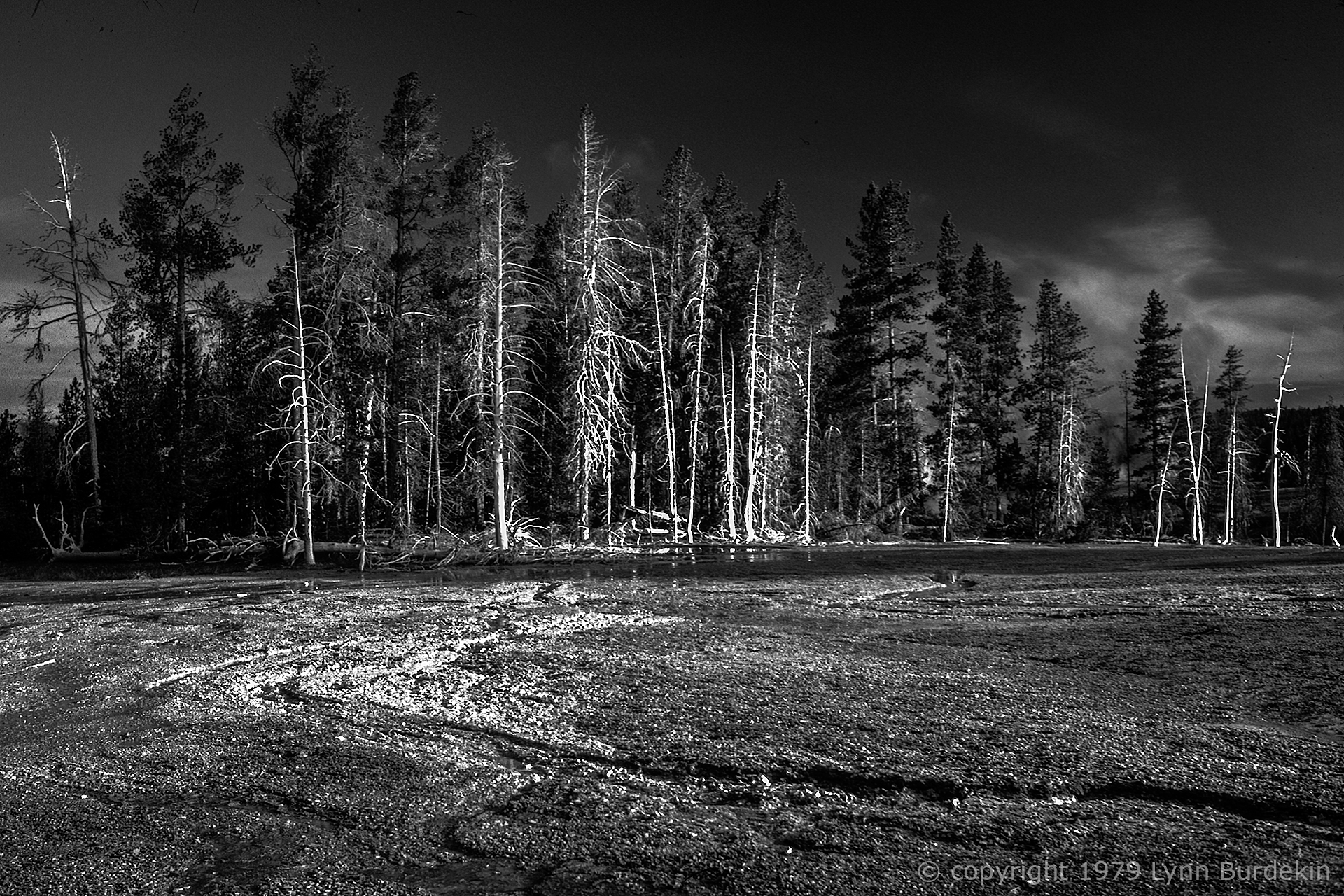

Last edited:
Share:
-
This site uses cookies to help personalise content, tailor your experience and to keep you logged in if you register.
By continuing to use this site, you are consenting to our use of cookies.


